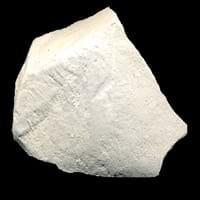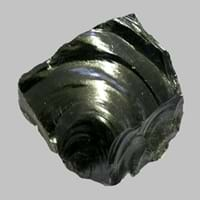Definition
Chalk is a soft, white, powdery limestone consisting mainly of fossil shells of foraminifers
Obsidian is a naturally occurring volcanic glass formed as an extrusive igneous rock. It is produced when felsic lava extruded from a volcano cools rapidly with minimum crystal growth
Discoverer
Unknown
Obsius
Etymology
From old English cealc chalk, lime, plaster; pebble, from Greek khalix small pebble, in English transferred to the opaque, white, soft limestone
From Latin obsidianus, misprint of Obsianus (lapis) (stone) of Obsius
Class
Sedimentary Rocks
Igneous Rocks
Sub-Class
Durable Rock, Soft Rock
Durable Rock, Medium Hardness Rock
Group
Not Applicable
Volcanic
Other Categories
Fine Grained Rock, Opaque Rock
Opaque Rock
Texture
Clastic or Non-Clastic
Glassy
Color
Grey, White, Yellow
Black, Blue, Brown, Green, Orange, Red, Tan, Yellow
Durability
Durable
Durable
Interior Uses
Decorative Aggregates, Homes, Interior Decoration
Decorative Aggregates, Interior Decoration
Exterior Uses
As Building Stone, As Facing Stone, Paving Stone, Garden Decoration
Garden Decoration
Other Architectural Uses
Powder
Not Yet Used
Construction Industry
As Dimension Stone, Cement Manufacture, Construction Aggregate, for Road Aggregate, Making natural cement, raw material for manufacture of quicklime and slaked lime, Source of calcium
Arrowheads, Cutting Tool, Knives, Scrapers, Spear Points
Medical Industry
Not Yet Used
Surgery
Antiquity Uses
Artifacts, Monuments, Sculpture, Small Figurines
Artifacts, Jewellery
Commercial Uses
Alumina Refineries, Creating Artwork, Drawing on blackboards, Gymnasts, athletes and mountain climbers use for grip, In aquifers, Paper Industry, Production of Lime, Raw material for manufacture of quicklime, slaked lime, Soil Conditioner, Whiting, Whiting material in toothpaste, paint and paper
Creating Artwork, Mirror, Used in aquariums
Types
Not Available
Fireworks Obsidian, Mahogany, Sheen Obsidian, Snowflake obsidian and Velvet Peacock Obsidian
Features
Clasts are smooth to touch, Is one of the oldest rock, Smooth to touch, Very fine grained rock
Blocks negativity, Helps to protect against depression
Archaeological Significance
Monuments
Used
Not Yet Used
Famous Monuments
Data Not Available
Not Applicable
Sculpture
Used
Not Yet Used
Famous Sculptures
Data Not Available
Not Applicable
Figurines
Used
Not Yet Used
Formation
Chalk is formed from lime mud, which accumulates on the sea floor which is then transformed into rock by geological processes.
When the lava is released from volcano, it undergoes a very rapid cooling which freezes the mechanisms of crystallization. The result is a volcanic glass with a uniform smooth texture.
Mineral Content
Calcite, Clay, Clay Minerals, Quartz, Sand
Not Available
Compound Content
Ca, NaCl, CaO
Aluminium Oxide, CaO, Iron(III) Oxide, FeO, Potassium Oxide, MgO, MnO, Sodium Oxide, Phosphorus Pentoxide, Silicon Dioxide, Titanium Dioxide
Types of Metamorphism
Not Applicable
Burial Metamorphism, Cataclastic Metamorphism, Contact Metamorphism
Types of Weathering
Biological Weathering, Chemical Weathering
Biological Weathering, Chemical Weathering, Mechanical Weathering
Types of Erosion
Chemical Erosion, Coastal Erosion, Water Erosion
Chemical Erosion, Coastal Erosion, Glacier Erosion
Grain Size
Very fine-grained
Not Applicable
Fracture
Not Available
Conchoidal
Porosity
Highly Porous
Very Less Porous
Compressive Strength
Not Available
Cleavage
Non-Existent
Non-Existent
Toughness
1
Not Available
Specific Gravity
2.3-2.4
2.6-2.7
Transparency
Opaque
Translucent
Density
2.49-2.50 g/cm3
2.6 g/cm3
Resistance
Heat Resistant
Heat Resistant, Impact Resistant
Deposits in Eastern Continents
Asia
Brunei, India, Indonesia, Malaysia, Singapore, Thailand, Vietnam
Afghanistan, Indonesia, Japan, Russia
Africa
Cameroon, Chad, Ghana, Kenya, Malawi, Sudan, Tanzania, Togo, Zambia, Zimbabwe
Kenya
Europe
England, France, Germany, Spain, United Kingdom
Greece, Hungary, Iceland, Italy, Turkey
Others
Not Yet Found
Not Yet Found
Deposits in Western Continents
North America
Canada, USA
Canada, Mexico, USA
South America
Colombia
Argentina, Chile, Ecuador, Peru
Deposits in Oceania Continent
Australia
Adelaide, New Zealand, Queensland, Tonga, Victoria, Yorke Peninsula
New Zealand
All about Chalk and Obsidian Properties
Know all about Chalk and Obsidian properties here. All properties of rocks are important as they define the type of rock and its application. Chalk belongs to Sedimentary Rocks while Obsidian belongs to Igneous Rocks.Texture of Chalk is Clastic or Non-Clastic whereas that of Obsidian is Glassy. Chalk appears Soft and Obsidian appears Shiny. The luster of Chalk is dull while that of Obsidian is vitreous. Chalk is available in grey, white, yellow colors whereas Obsidian is available in black, blue, brown, green, orange, red, tan, yellow colors. The commercial uses of Chalk are alumina refineries, creating artwork, drawing on blackboards, gymnasts, athletes and mountain climbers use for grip, in aquifers, paper industry, production of lime, raw material for manufacture of quicklime, slaked lime, soil conditioner, whiting, whiting material in toothpaste, paint and paper and that of Obsidian are creating artwork, mirror, used in aquariums.









